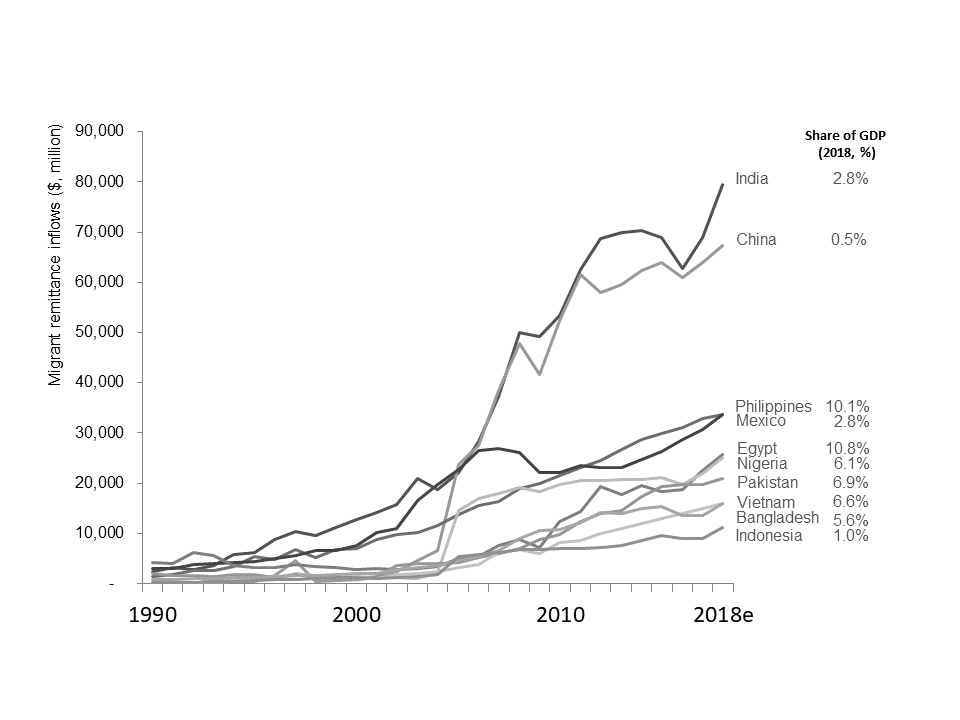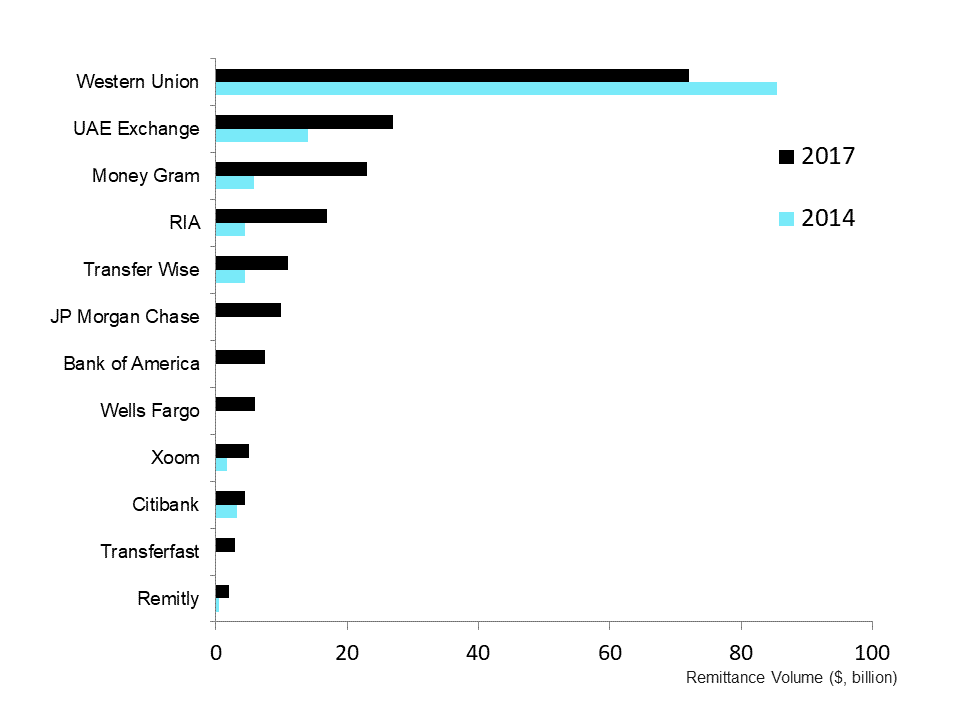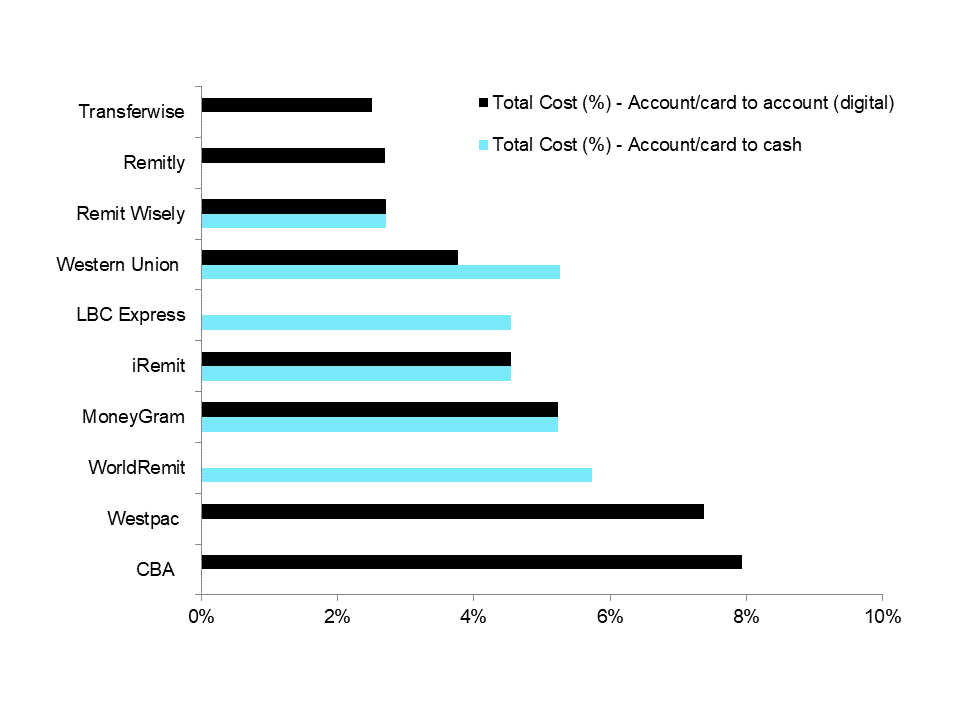- Global consumer remittances total more than $600 billion and generate $30 billion in fees, yet processes can be slow and expensive.
- Fintechs are developing safe, fast and cheaper ways to send money but are constrained by the financial system and payments infrastructure
- Banks are striving to compete better by adopting both blockchain and SWIFT gpi
Total global remittances rose about 7% in 2017 to $613 billion, with about 76% of that amount going to low- and middle-income countries. Volume is expected to continue rising to close to $750 billion by 2020. About 400 million people in Asia are directly affected by remittances as a sender or receiver.
Asian countries remain the largest recipients of international remittances, and the funds are a major component of GDP in many countries
Figure 21: Top 10 migrant remittance receiving countries (2018)

Note: All numbers are in current (nominal,$),
Source: World Bank
Given that remittance volumes and revenue are so huge, fintechs have plunged into the field. Indeed, the World Economic Forum (WEF) said that there are now more than 3,000 remittance service providers worldwide, creating greater competition and transparency. While Western Union is more than double the size of its largest money transfer operator(MTO) competitors, as shown in Figure 2, other competitors are growing rapidly.
While traditional players still dominate international remittances, newer companies such as TransferWise, RIA and Xoom have increasing market shares.
Figure 2: Remittances Volume ($, billion, 2014,2017)

Source: Asian Banker Research
A big growth area for MTOs has been mobile money transfers using apps or text messages, which offer convenience and security as well as lower fees and notification when money has arrived. The industry estimates that currently between 8 to 11% of global remittances are digital on the sending side but according to WorldRemit the sector is predicted to be 60% digital by 2021 on the sending side.
TransferWise, for example, offers fast remittances at low costs using an app or Facebook, and its chatbot helps users complete transactions. Platforms such as Facebook enable peer-to-peer payments in selected markets, while WhatsApp and Tencent's WeChat Pay also allow transfers via messages. Alipay offers highly competitive services in China and is expanding overseas, with Alipay's Hong Kong-Philippines service offering free remittances initially being one example.
The reason for MTO growth is straightforward. Many MTOs provide the real-time payments, full transparency, lower fees and digitised services that consumers demand.
Transferwise, one of the fastest growing global neo MTOs is breaking the inertia in remittances and solving problems, said TransferWise Head of Banking Lukas May, as more people realise it shouldn't take five days and cost 5% to send money.
From the outset, May said, TransferWise has made transfers transparent, low-cost and instant. Customers were so impressed with the experience that they became "evangelical", so 70% of growth has come from for word-of-mouth promotions. While many banks are continuing with their current models, May said "banks are starting to realise the game can't go on forever." TransferWise offers APIs and is open to banks integrating as long as fees are transparent. One challenge, May admitted, is that "we're held back by payment systems we operate in." Many switches are still not real-time, though recent launches in Australia and other markets helped the percentage of instant payments increase from 8% in June to 20% by September 2018.
Even though MTOs have grown, they are constrained by the financial system. Increasing numbers of banks won't sponsor smaller MTOs because of high compliance costs or de-risking, MTOs struggle with the capital costs of holding funds in multiple locations, and many MTOs have small IT teams with limited budgets. While blockchain-based remittance solutions could well reduce these constraints, enabling smaller MTOs to flourish, large-scale rollout of blockchain-based remittances will take time.
Despite the challenges, MTOs are beginning to have a significant impact on fees, which have remained stubbornly high. Despite a commitment by the G20 in 2011 to reduce the cost of remittances to 5% and a target in the UN Sustainable Development Goals to reduce fees to 3%, average global costs declined only slightly between 2011 and 2017 from 9.2% to 7%. Fees also vary widely depending on the amount, transfer method and remittance corridor. The World Bank estimated the total average cost of a $200 transfer in the 3rd quarter of 2018 from the US to Mexico or India at $8.11 and $5.63 respectively, from Australia or the UAE to the Philippines at $10.77 and $21.65 respectively, and from South Africa to Botswana at $36.60. The aggregate cost of sending remittances in 2017 was about $30 billion. Mobile transfer operators (MTOs) consistently offer lower costs compared to banks, with an average fee of 3.20%, according to World Bank data.
Fees vary widely between remittance providers
Figure 3: Average cost of sending a $200 remittance (3rd Quarter 2018) from Australia to the Philippines

Source: World Bank
Bank innovate to recover lost ground
While MTOs are increasing their volumes, banks still have a large market share. Banks handle about 60% of consumer cross-border remittances in the US, for example, and the top five remittance providers in Korea are four large banks plus Western Union. Seeing the high levels of competition, however, banks have begun to innovate more.
Banks including UBS and Barclays are developing a "Utility Settlement Coin" that would be convertible to foreign currencies and would be used to settle international transfers, for instance, giving banks efficient settlement and greater transparency.
SWIFT gpi also offers faster transactions, predictable settlement times, clear statuses and greater transparency. Since its 2017 launch, SWIFT gpi has gained the support of over 300 financial institutions, including the world's 60 biggest banks. It is now being used to send hundreds of billions in payments every day, many of which are made within minutes or even seconds, and accounts for 55% of SWIFT's cross-border traffic. SWIFT is also working with banks in Asia on an instant cross-border gpi payments service for P2P and SME payments. But banks also look for an alternative 'rail' which is secure and scalable, cost and time-efficient.
Blockchain-based remittances are growing as well. The open Interledger Protocol (ILP), for instances, is used by banks such as Santander to offer global remittance services. At the same time it has gone live with SWIFT GPI for cross-border payments. Ripple is working with more than 100 banks globally to establish a global payments network that would provide instant, affordable and transparent transfers. SBI Remit and Siam Commercial Bank are leveraging RippleNet to power real-time remittances between Japan and Thailand, for instance, and more than 60 banks in the Japan Bank Consortium recently unveiled a RippleNet-powered app for real-time domestic transfers. Ripple announced in January 2019 that its surpassed 200 customers on RippleNet. A handful of those will use XRP for on demand liquidity.
Individual banks have also designed innovative solutions, such as a partnership by KBZ Bank and Kasikorn Bank that enables migrant workers in Thailand to scan bar codes at Kasikorn Bank ATMs for transfers that accountholders in Myanmar can withdraw at KBZ. Some banks have also begun offering zero-fee remittances with lower foreign exchange rates, such as DBS Bank's zero-fee transfers to selected countries with about a 1% FX mark-up. And another tactic has been to act as the back office for MTOs. Standard Chartered Bank, for instance, is the partner bank for Ant Financial's new blockchain cross-border remittances, starting with the Hong Kong-Philippine corridor and expanding to other countries.
This doesn't mean that all banks are doing more, of course. While remittances are an important revenue source in some countries, it's a small percentage at many banks in Europe or North America. For instance, at Wells Fargo, fee income from wire transfer and remittance services contributes 1.2% to total bank fees as of 2017, yet it represents the fastest growing fee segment since 2015 growing by 21% between 2015 and 2017. By contrast, China Merchants Bank earns almost 15% from remittance and settlement fees to total bank fee income.
Given their low contribution to overall fee and revenue income, most banks do not see remittances as a strong revenue opportunity but a value-added service. Remittances have also become increasingly difficult to manage due to increasing costs for technology and regulatory compliance.
Case Studies
ICICI Bank
The two key issues consumers have always had with remittances, said Suman Das, Head NRI Services & Global Remittances at ICICI Bank, are the cost and time to send money. Fulfilment, however, remained a challenge for lack of evolved payment ecosystems whether in the country of origination or that in the destination. Most of the banks worldwide do not see remittances as a strong revenue opportunity. ICICI Bank is different, Das said, and has seen opportunities in remittances as far back as 2003. "There are certain things we can do that a non-bank cannot do like providing variable benefits to savings account relationship that receives remittances."
Apart from developing direct-to-customer online services more than a decade ago, ICICI Bank has been innovating to keep the service relevant. For example, ICICI Bank launched a Social Pay feature in its Money2India app that uses a social media contact instead of the beneficiary's account details. Users can also make voice based remittances through the IOS version of the app. The bank was also the first bank in India to launch an online portal for its own customers as well as for non-customers to send payments abroad, the first to go to live on SWIFT gpi and the first to offer real-time cross-border remittances on blockchain.
"Most of our processes are automated," Das said. "That helps us to offer pricing that is competitive. We have about 950 robotic applications in the bank that do not require a human being." ICICI Bank also has over 250 correspondent relationships all over the world, he noted, and close to 60% of payments use bilateral APIs. ICICI Bank has used these and other partnerships to enable SMS confirmation of remittances within a few minutes.
Going forward, Das said, "we see a lot of value in both SWIFT gpi, and blockchain. Our strategy is to be the conduit of interoperability across ecosystems." Both ecosystems promise to enable faster remittances with absolute transparency.
Alliance Bank
Banks are also competing better by offering specialised solutions that meet specific customer needs, such as Alliance Bank's Cash2Home service.
Employers are caught between paying workers in cash or sending them to bank branches, Alliance Bank found, and often opt to use a cash payroll even if it means dealing with robberies. At the same time, foreign workers don't have a safe place to keep their money and take time off to send money home. Seeing that the banking community had underserved the community, Alliance Bank designed an onboarding process by analysing each step and involving employers as well as foreign workers. The Bank found that it is difficult to for workers to read, so they developed videos that workers can watch on the phone and follow step-by-step. Workers can open an account, set an ATM PIN, sign so they can an access branch, activate an app to send remittances, and do balance inquiries and rewards. They can use the mobile banking service to send money anytime.
Alliance Bank partnered with companies to get access to foreigner workers and with fintechs overseas for cash pay-out in foreign countries. It also introduced competiton at overseas partners to make sure prices are competitive.
Move Fast
Given that remittances are so lucrative in so many markets in Asia, and that new competitors are offering faster and cheaper services, banks will need to develop new models if they want to keep their customers. Whether they develop their own service or partner with newer players, banks will need to move fast to retain their role – and their revenue.
































